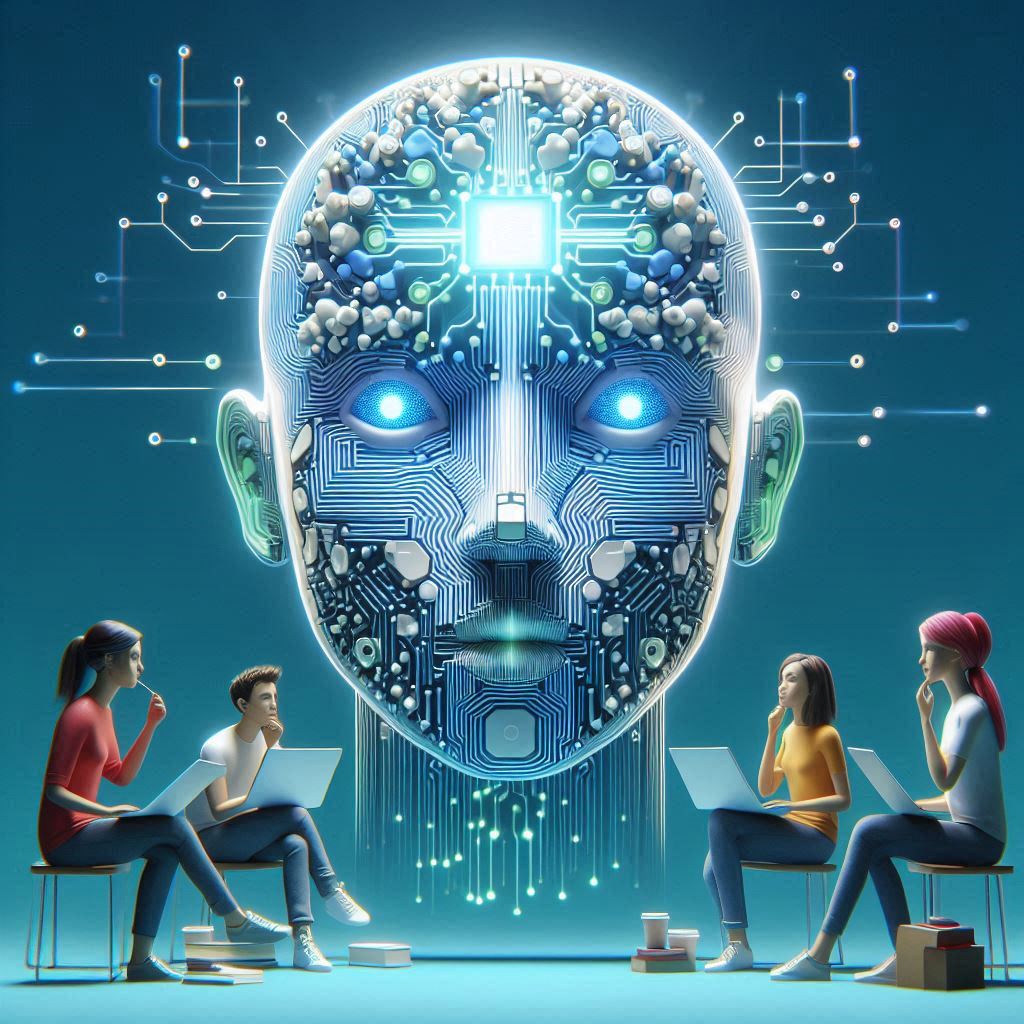OpenAI’s GPT: Revolutionizing Natural Language Processing
Introduction to Open AI’s GPT
Open AI’s Generative Pre-trained Transformer (GPT) has revolutionized Natural Language Processing (NLP), enabling machines to comprehend and generate human-like text with unprecedented accuracy and fluency. This breakthrough is powered by its ability to learn from vast amounts of text data, allowing it to understand context, generate coherent responses, and even mimic human creativity in language use.
Applications Across Industries
The impact of GPT spans across diverse industries. In healthcare, GPT has been utilized for diagnostics, analyzing patient symptoms to provide accurate medical insights and recommendations. In finance, it enhances customer service through responsive chat bots that can handle complex queries efficiently. Moreover, in scientific research, GPT aids in data analysis and hypothesis generation, accelerating discoveries and innovations.
Versatility and Transformative Impact
GPT’s versatility lies in its adaptability to various tasks without extensive retraining, making it a cost-effective solution for businesses seeking to integrate AI into their operations. Its transformative impact on AI technologies is evident in how it streamlines processes, improves decision-making, and enhances user interactions across different platforms and applications.
Technological Advancements and Future Prospects
GPT continues to evolve, driving innovations in AI applications. Institutions like MIT are exploring its potential in scientific research, demonstrating its adaptability and robustness in handling complex datasets and accelerating data-driven insights.
Conclusion
With its transformative capabilities, GPT stands as a pivotal advancement in AI, reshaping industries and paving the way for more intelligent and efficient systems in the future.
1. Ability to adapt to various tasks without extensive retraining 2. Applications across different industries: healthcare, finance, research
C. Scalability 1. Capability to handle large volumes of data effectively 2. Scalable solutions for businesses and research institutions
D. Time and Cost Efficiency 1. Reduced development time due to pre-trained models 2. Cost-effective implementation compared to building from scratch
E. Innovation Driver 1. Facilitation of new applications and use cases in AI 2. Role in pushing the boundaries of what’s possible in NLP
III. Cons of Open AI’s GPT
A. Ethical Concerns 1. Issues related to bias in language generation 2. Privacy concerns regarding data handling and usage
B. Dependency on Data Quality 1. Impact of data quality on model performance 2. Challenges in sourcing and maintaining diverse datasets
C. Lack of Contextual Understanding 1. Instances where GPT fails to grasp context accurately 2. Limitations in handling nuanced or ambiguous language
D. Resource Intensiveness 1. High computational resources required for training and inference 2. Accessibility barriers for smaller organizations or research groups
E. Regulatory and Legal Issues 1. Compliance challenges with data protection regulations 2. Legal implications of AI-generated content and its use
IV. Case Studies and Examples
A. Successful Implementations 1. Examples of companies or institutions leveraging GPT effectively 2. Impact on operational efficiency and customer satisfaction
B. Challenges Faced 1. Real-world issues encountered during implementation 2. Strategies adopted to overcome challenges or limitations
V. Future Outlook
A. Advancements and Innovations 1. Research directions in enhancing GPT’s capabilities 2. Potential applications in emerging fields like AI ethics and sustainability
B. Mitigating Challenges 1. Efforts in addressing ethical and regulatory concerns 2. Technological developments to improve model robustness and performance
VI. Conclusion
- Recap of the pros and cons discussed
- Final thoughts on the transformative impact of GPT in NLP
- Considerations for future developments and adoption
This outline provides a structured approach to exploring both the benefits and drawbacks of Open AI’s GPT in NLP, supported by case studies and future outlooks. Each section can be expanded into detailed discussions and examples to enrich the understanding of GPT’s role in modern AI applications.

Frequently Asked Questions (FAQs) about Open AI’s GPT in Natural Language Processing
1. What is Open AI’s GPT?
Open AI’s Generative Pre-trained Transformer (GPT) is an advanced AI model designed for Natural Language Processing (NLP). It uses deep learning techniques to understand and generate human-like text based on vast amounts of data it has been trained on.
2. How does GPT work?
GPT works by using a transformer architecture that processes input text in a hierarchical manner, learning relationships and patterns within the text data. It utilizes self-attention mechanisms to weigh the importance of different words in context, enabling it to generate coherent responses or complete text based on the input it receives.
3. What are the key features of GPT?
GPT is known for several key features:
- Language Comprehension: Ability to understand and interpret human language with high accuracy.
- Text Generation: Capacity to generate contextually relevant and coherent text.
- Versatility: Adaptability to various NLP tasks without extensive retraining.
4. What are the applications of GPT?
GPT has diverse applications across industries:
- Customer Service: Enhancing chatbot interactions for improved customer support.
- Healthcare: Assisting in medical diagnostics and patient data analysis.
- Finance: Automating processes like risk assessment and fraud detection.
- Research: Supporting scientific discoveries through data analysis and hypothesis generation.
5. How accurate is GPT in generating human-like text?
GPT has shown impressive accuracy in generating human-like text, often indistinguishable from texts written by humans. Its performance depends on the quality and diversity of the data it has been trained on, as well as the complexity of the tasks it is applied to.
6. What are the advantages of using GPT?
- High Accuracy: Ability to generate text with minimal errors and high coherence.
- Efficiency: Saves time and resources in developing NLP applications due to pre-trained models.
- Scalability: Can handle large volumes of data and diverse tasks effectively.
- Innovation: Facilitates new applications and advancements in AI technologies.
7. What are the challenges associated with GPT?
- Bias and Fairness: Risk of perpetuating biases present in training data.
- Contextual Understanding: Difficulty in grasping nuanced or ambiguous language.
- Resource Intensiveness: Requires substantial computational resources for training and deployment.
- Ethical Concerns: Privacy issues related to data handling and AI-generated content.
8. How can bias in GPT be mitigated?
Mitigating bias in GPT involves:
- Diverse Training Data: Using datasets that represent a wide range of perspectives and demographics.
- Bias Detection: Implementing algorithms to detect and mitigate biased outputs.
- Ethical Guidelines: Adhering to ethical guidelines and standards in AI development and deployment.
9. What are the future prospects of GPT?
- Enhanced Capabilities: Continued advancements in model architectures and training techniques.
- Ethical AI: Integration of ethical considerations into AI development processes.
- New Applications: Exploration of GPT’s potential in emerging fields like healthcare diagnostics, legal analysis, and creative content generation.
10. How does GPT contribute to AI research?
GPT serves as a cornerstone in AI research by:
- Pushing Boundaries: Extending the capabilities of NLP and AI-driven applications.
- Collaborative Efforts: Fostering collaboration among researchers to explore new frontiers in AI.
- Open-Source Initiatives: Contributing to open-source frameworks and tools that democratize access to advanced AI technologies.
11. What are some notable examples of GPT’s impact?
- Customer Support: Improving responsiveness and accuracy in automated customer service interactions.
- Medical Diagnosis: Assisting healthcare professionals in analyzing patient data for accurate diagnostics.
- Content Generation: Enabling creative industries to automate content creation tasks like writing and storytelling.
12. How can businesses integrate GPT into their operations?
Businesses can integrate GPT by:
- Developing Custom Applications: Tailoring GPT for specific business needs, such as customer service or data analysis.
- Partnering with AI Experts: Collaborating with AI experts to deploy and optimize GPT solutions.
- Continuous Learning: Keeping abreast of advancements in AI to leverage new features and capabilities of GPT.
This FAQ section provides a comprehensive overview of Open AI’s GPT in NLP, addressing common questions about its functionality, applications, benefits, challenges, and future directions. Each question can be expanded with specific examples, case studies, and technical details to cater to different levels of audience understanding and interest.
Disclaimer and Caution Regarding OpenAI’s GPT in Natural Language Processing
Introduction
OpenAI’s Generative Pre-trained Transformer (GPT) represents a significant advancement in AI technology, particularly in Natural Language Processing (NLP). However, its capabilities and deployment come with several considerations, including ethical implications, technical limitations, and potential risks. This disclaimer aims to provide a comprehensive overview of these aspects to help stakeholders make informed decisions about integrating GPT into their applications and projects.
1. Ethical Considerations
- Bias and Fairness: GPT, like other AI models, can reflect biases present in the data it was trained on, leading to biased outputs in language generation. Developers and users should implement strategies to mitigate bias and ensure fairness in applications.
- Privacy and Data Security: Using GPT involves handling large amounts of data, including potentially sensitive information. Careful consideration of data privacy regulations and best practices in data handling is essential to protect user privacy and maintain compliance.
- Ethical Use of AI: As AI technologies evolve, ethical guidelines and frameworks become increasingly important. Responsible deployment of GPT requires adherence to ethical standards, ensuring AI systems benefit society while minimizing potential harms.
2. Technical Limitations
- Contextual Understanding: While GPT excels in generating human-like text, it may struggle with nuanced context or understanding subtle implications in language. This limitation can affect the accuracy and appropriateness of generated content.
- Scalability and Resource Intensity: Implementing GPT effectively often requires substantial computational resources for training and inference. Small-scale organizations or projects may face challenges in accessing and managing these resources.
- Performance in Specific Domains: GPT’s performance can vary across different domains and tasks. Fine-tuning or adapting the model for specific applications may be necessary to achieve optimal results.
3. Risks and Challenges
- Misuse and Misinformation: Improper use of GPT can contribute to the spread of misinformation or generate inappropriate content. Robust content moderation and validation mechanisms are crucial to mitigate these risks.
- Dependency and Reliability: Businesses and developers should be aware of the potential dependency on AI models like GPT. Reliability issues, such as model updates or changes in performance over time, may impact operational continuity.
- Legal Implications: The use of AI-generated content raises legal questions regarding ownership, copyright, and accountability. Clear policies and legal frameworks should be established to address these concerns.
4. Recommendations for Responsible Use
- Transparency: Provide clear information to users when AI technologies like GPT are utilized, including disclosures about automated systems and the potential use of AI-generated content.
- Validation and Verification: Implement rigorous validation processes to ensure the accuracy and appropriateness of AI-generated outputs, especially in critical applications like healthcare or legal contexts.
- Continuous Monitoring and Improvement: Regularly monitor AI systems for biases, errors, and performance issues. Continual improvement through feedback loops and updates is essential to enhance reliability and user trust.
5. Future Directions and Industry Standards
- Advancements in AI Ethics: Continued research and development in AI ethics aim to establish industry standards and best practices for the responsible use of AI technologies like GPT.
- Collaboration and Knowledge Sharing: Stakeholders across industries should collaborate to share insights, tools, and methodologies for ethical AI development and deployment.
Conclusion
Open AI’s GPT offers transformative potential in NLP applications, but its adoption requires careful consideration of ethical, technical, and operational factors. This disclaimer underscores the importance of responsible AI use, highlighting the need for proactive measures to mitigate risks and maximize the benefits of AI technologies.
This disclaimer and cautionary section provides a detailed exploration of the considerations and challenges associated with using Open AI’s GPT in NLP, aiming to inform stakeholders about the responsible integration and deployment of AI technologies.

1 thought on “OpenAI’s GPT:”